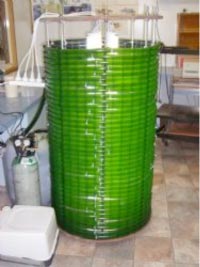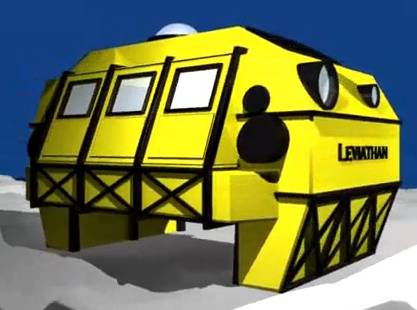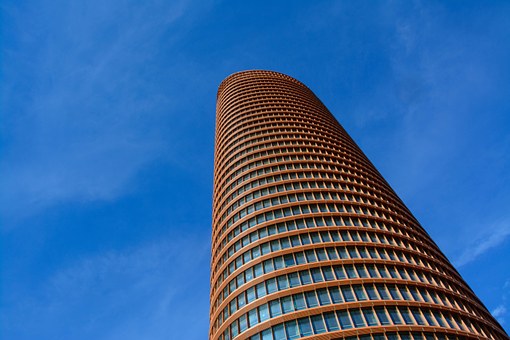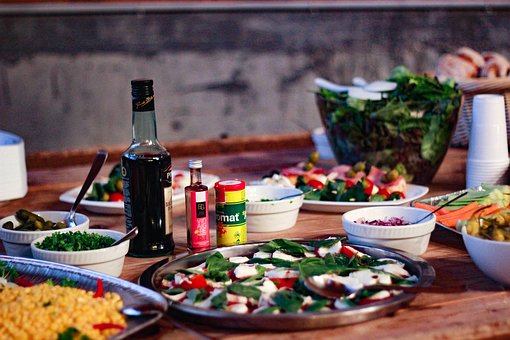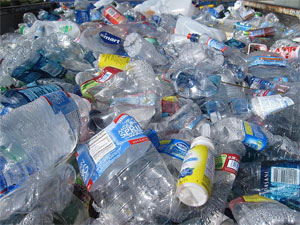Last April, science hobbyist Lloyd Godson surfaced after surviving 13 days underwater in a lake near Albury, Australia. Godson’s underwater habitat, the BioSUB, was designed to simulate a closed, autonomous environment. Using a Biocoil, a gas-exchange system that utilizes the photosynthetic properties of chlorella algae when supplied with carbon dioxide, light, and water, Godson was able to generate his own oxygen. In addition, he modified a stationary bicycle to operate as a power generator to charge his laptop’s battery while he remained submerged. While he still needed to rely on external sources of air and power, Godson was the first person to ever use a plant-based life support system in a closed environment. Currently, Godson is collaborating on a new project that aims to initiate a full-scale underwater colonization by 2012. Godson’s work with the Chlorella species gives an exciting outlook on the future of algae in closed environments as a source of oxygen and nutrition.
Introduction
If “Living Your Dream” includes isolating yourself in a metal box at the bottom of a lake, you have a lot in common with science hobbyist Lloyd Godson. This past April, Godson resurfaced after 13 days of living completely submerged at the bottom of a lake near Albury, Australia. The goal of this project was to investigate the feasibility of a closed, self-sustaining environment. Funded by Australian Geographic magazine, he constructed an 8-by-10-foot ‘BioSUB’, which used a series of components to create a partially autonomous environment. Godson generated his own oxygen using a ‘Biocoil,’ a gas-exchange system that utilizes the photosynthetic properties of chlorella, a species of single-celled algae [1]. For electricity, he pedaled a stationary bicycle attached to a generator. This device provided the power necessary to run both Godson’s laptop battery and the water pump for the ‘Biocoil.’ This equipment had to be supplemented by external air compressors and solar panels to ensure Godson’s survival [2].
While the BioSUB was not completely self-sufficient due to these external aids, the BioSUB project is still seen as a huge accomplishment. Spending 13 days underwater did not break any records, but by using the Biocoil, Godson became the first person to live in a self-sustaining, closed environment [1]. The success of Lloyd Godson’s experiment serves as an exemplary feat in the fields of science and engineering, and it offers insight into the future of studies on undersea habitats and autonomous environments.
The Biocoil
Of all the engineering innovations present aboard the BioSUB, the specially-designed Biocoil is the most significant (see Fig. 1). When researching different air supply systems for the BioSUB Project, Godson contacted Cascade High School in Idaho, where the school’s advanced biology students had spent over a decade researching the properties of the chlorella algae and constructing Biocoils [3]. Chlorella possesses a high photosynthetic efficiency and only requires carbon dioxide, water, light, and a small amount of minerals to rapidly produce energy [4]. Essentially, a Biocoil is a photosynthetic bioreactor that consists of a series of coiled, plastic tubing filled with water and chlorella. The design of the Biocoil maximizes the amount of light available to the chlorella to assist their rate of photosynthesis [5]. In Godson’s case, the carbon dioxide required for photosynthesis was provided by his own respiration, and his urine was recycled to provide the nutrients also required for the process. In this way, Godson and the Biocoil were able to interact in a self-sufficient “human-plant symbiosis” [2].
Generating electricity was another challenge Godson faced while designing the BioSUB. He solved this problem by designing his own stationary bicycle to generate power. Following “do it yourself” instructions, he built his own pedal-powered 12-volt DC generator. The main function of the generator was to charge Godson’s laptop battery, which he used for entertainment and to create videos and messages to document his experience. In addition to its power generating capabilities, the bicycle could also be attached to the Biocoil to serve as a pump if his primary electric pump were to fail. Since the bike generator only powered these two functions, both methane fuel cells and solar panels on the surface of the lake powered the rest of the BioSUB [6]. Although his small bicycle generator was not able to support the electrical needs of the entire BioSUB, Godson’s experiment in electricity generation suggests exciting possibilities for complete electrical sustainability in the future.
Fundamentals of Underwater Habitats
Over the last 50 years, engineers and scientists have come a long way in the manufacture and design of underwater habitats. The first habitats of this type were constructed for marine research and excavation. Once space travel was introduced, the demand for such habitats rose for the purpose of studying individuals in closed environments under different pressures. This information was then adapted to space stations to best support the astronauts. Recently, there has been an increased interest in general undersea occupation, as the idea of sustainable living has gained popularity and issues with construction and other limitations of underwater systems have been overcome.
The general shape of underwater habitats is an important component in their design. A spherical shape is the best choice, primarily because it requires the minimum amount of material to enclose a given volume and holds up well under internal pressure. Materials selected for habitats are typically corrosion-resistant and consist of glass, ceramics, and high-strength metals such as steel, titanium, and aluminum. Other materials need to be considered for individual parts, such as ports and windows, hatches, insulation, transportation, and surface-support equipment. General parameters that need to be considered during construction are purpose, size, configuration, operational depth, air and water temperatures, manufacturing, and maintenance techniques, and transportation to the operational site [7].
With respect to oxygen intake, the most economical breathing gas system is a shore-based compressor that pumps a continuous flow of air into the habitat, similar to the supplemental oxygen supplied to Godson in the BioSUB. This type of intake is safe for up to 50 feet in depth. At deeper levels, a mixture of nitrogen and oxygen is required. All undersea environments must also have a system for removing carbon dioxide. The primary source of CO2 production in a habitat is the inhabitants’ expired gas (exhaled breaths). There are several CO2 absorbents commercially available, but scrubber systems are now becoming more popular. A ‘scrubber’ consists of a fan that draws air from the habitat atmosphere, forces it through the chemical agent where CO2 is removed, and subsequently redistributes it throughout the habitat [7].
Besides the engineering challenges in designing underwater habitats, very high costs are required to operate them. Complete independence from the surface has not been accomplished yet because of these high operation prices. The development of autonomous habitats like the one Godson was exploring would help to decrease these prices by removing the cost of support ships and surface crews. Besides the financial barriers, other limitations include the lack of habitat mobility and the fact that surface-controlled robots may be more cost effective than underwater human researchers [7].
The Future of Underwater Habitats
Currently, Lloyd Godson is working with marine researcher Dennis Chamberland on another underwater habitat project. Expected to launch in 2009, the project will entail Chamberland spending 80 days underwater off the coast of Florida in his Leviathan habitat (see Fig. 2). The purpose of this new project is to push the limits of human design and break the existing 69-day record for underwater survival. The Leviathan will have several specially engineered features, including a triply-redundant system of air conditioners, dehumidifiers, and air circulators. The oxygen supply will come from surface-mounted air compressors in conjunction with carbon dioxide scrubbing systems to absorb the carbon dioxide exhaled by the passengers. Power will be supplied by four wind generators and a bank of solar panels. Plans have also been made to accommodate digital communications, a functioning laboratory, and an entertainment space [8]. When asked if he would participate in the mission, Godson declined, stating that he “likes the things we have up here” [2].
Chamberland and his team are already looking even further into the future. By 2012, he plans to launch the Challenger Station, a much larger habitat designed to be the first step in developing a permanent undersea colony named Atlantica. One of the key purposes of the Leviathan project is to test systems and procedures that will be used in the Challenger Station habitat [8].
Besides the projects imagined by Chamberland, the chlorella algae Godson used also provides an exciting possibility for future use in underwater habitats. The algae can serve a dual purpose: providing a source of oxygen through photosynthesis and being edible and rich in protein. In fact, during the 1940’s and 1950’s, many thought that chlorella would become a staple in typical American diets. Chlorella was seen as the answer to the need for cheap food for large populations, as it “tapped the virtually infinite supply of ‘free’ solar energy, water, and CO2” [9:621]. However, more research revealed the downsides to eating chlorella. The algae proved to be temperature-sensitive, difficult to preserve, relatively expensive, and difficult to digest. Cooking chlorella improves digestibility, but the heat reduces its nutritional benefits. Additionally, vitamins are destroyed when removing the seaweed taste and green color.
However, Godson’s use of the Biocoil may be a reason to give chlorella another chance. The Biocoil provides a controlled, contamination-free environment and can be operated at much higher cell densities than with traditional systems. According to the Journal of Applied Phycology, “Not only can high productivities be achieved, but the controlled conditions in these bioreactors permit the production of algal biomass of high nutritional value” [10]. Essentially, the Biocoil provides an opportunity to produce chlorella under favorable conditions in a controllable environment at faster rates. If the chlorella algae can be engineered and developed further to generate sufficient amounts of oxygen and provide nutritional meals, environmental sustainability may be possible sooner than we think.
Conclusion
Lloyd Godson’s BioSUB project serves as a breakthrough in the studies of underwater habitats and the progression of self-sustaining, self-sufficient environments. Besides their role in conducting undersea studies, these developments in science, technology, and engineering may also prove important for space travel or other self-sustaining activities. Whether or not the discoveries learned from underwater habitats prove useful, we are certainly coming closer to inhabiting a new underwater frontier and this is exciting news!
